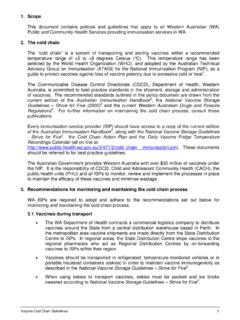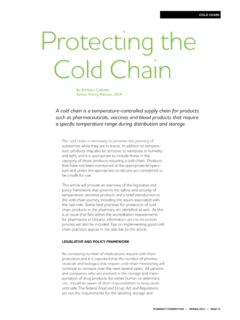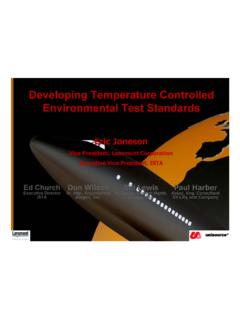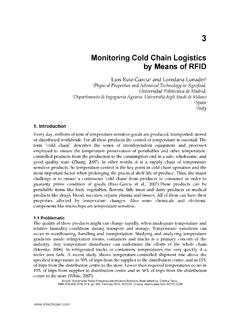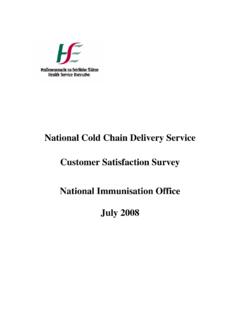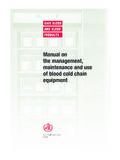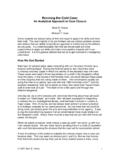Transcription of The vaccine cold chain - WHO
1 2: The vaccine cold chain 2. About this module . The vaccine cold chain The purpose of the vaccine cold chain is to maintain product quality from the time of manufacture until the point of administration by ensuring that vaccines are stored and transported within WHO-recommended temperature ranges. This module provides guidance for workers at health facility level. It covers the use of cold chain and temperature monitoring equipment and the basic maintenance of cold chain equipment. The module describes the existing range of WHO prequalified equipment at the time of publication. Up-to-date information on prequalified equipment is available on the WHO. Performance Quality Safety (PQS) website ( vaccine_quality/pqs_catalogue/). Some of the figures in this module show equipment from specific manufacturers. This is for illustrative purposes only and does not indicate WHO official endorsement of these products. Module 2: The vaccine cold chain Contents 1. The cold chain .
2 (2)3. Temperature requirements for vaccines .. (2)4. The cold chain at health centre or peripheral health facility level .. (2)6. 2. Health facility cold chain equipment ..(2)7. Refrigerators .. (2)7. cold boxes .. (2)11. vaccine carriers .. (2)12. Water packs .. (2)12. Foam pads .. (2)14. 3. Temperature monitoring devices ..(2)15. Monitoring heat exposure using vaccine vial monitors .. (2)15. Temperature monitoring devices .. (2)18. Recommended equipment .. (2)21. 4. Monitoring cold chain temperatures ..(2)23. Monitoring vaccine refrigerator temperature .. (2)23. Taking action when a vaccine refrigerator's temperature is out of range .. (2)25. Maintaining the correct temperature in cold boxes and vaccine carriers .. (2)26. 5. Arranging vaccines inside cold chain equipment ..(2)27. General rules for using vaccine refrigerators .. (2)27. Specific rules for using front-opening refrigerators .. (2)29. Specific rules for using top-opening refrigerators without baskets.
3 (2)32. Specific rules for using top-opening refrigerators with baskets .. (2)33. Preparing ice packs and cool water packs .. (2)35. Packing vaccines in cold boxes and vaccine carriers .. (2)37. 6. Basic maintenance of cold chain equipment ..(2)39. Defrosting vaccine refrigerators .. (2)39. Maintaining solar power systems .. (2)40. Maintaining gas refrigerators .. (2)41. Maintaining kerosene refrigerators .. (2)41. Managing vaccine refrigerator breakdowns .. (2)42. Maintaining cold boxes and vaccine carriers .. (2)43. 7. The Shake Test ..(2)44. What is the Shake Test? .. (2)44. When is the Shake Test needed? .. (2)44. How is the Shake Test done? .. (2)44. (2)2 Immunization in practice Module 2: The vaccine cold chain 1 The cold chain The system used for storing vaccines in good condition is called the cold chain . It is sometimes referred to as the vaccine supply chain , or the immunization supply chain . The cold chain consists of a series of links that are designed to keep vaccines within WHO recommended temperature ranges, from the point of manufacture to the point of administration.
4 Figure illustrates the complete cold chain . The bottom row of arrows shows the flow of vaccines down to the health facilities; the top row of arrows shows where data are collected, recorded, checked and analysed, and how reporting information flows back up the chain . Following this sequence ensures that cold chain performance is properly monitored and that the necessary information is gathered for vaccine forecasting. Figure The cold chain Manufacturer Request for supply Annual statistics and estimates Airport Analysis Monthly report/. checking Central store Daily record District/. regional store Health centre Vaccinator/. mother and child Source: PATH/WHO. In order to maintain a reliable vaccine cold chain at the peripheral level, the following key procedures must be observed: store vaccines and diluents within the required temperature range at all sites pack and transport vaccines to and from outreach sites according to recommended procedures keep vaccines and diluents within recommended cold chain conditions during immunization sessions.
5 Section 5 of this module describes how to store and pack vaccines at health facility level. Immunization in practice (2)3. Module 2: The vaccine cold chain Temperature requirements for vaccines Vaccines are sensitive biological products. Some vaccines are sensitive to freezing, some to heat and others to light. vaccine potency, meaning its ability to adequately protect the vaccinated patient, can diminish when the vaccine is exposed to inappropriate temperatures. Once lost, vaccine potency cannot be regained. To maintain quality, vaccines must be protected from temperature extremes. vaccine quality is maintained using a cold chain that meets specific temperature requirements. Figure shows recommended vaccine storage temperatures at each level of the cold chain . It is essential that all those who handle vaccines and diluents know the temperature sensitivities and the recommended storage temperatures for all the vaccines in the national schedule. Figure Recommended vaccine storage temperatures National Sub-national District Service (up to 6 months) (up to 3 months) (up to 1 months) (up to 1 months).
6 +8 C. Liquid Lyophil Liquid Lyophil Liquid Lyophil Liquid Lyophil All All OPVs OPVs +2 C. 15 C. Acceptable Acceptable All All Lyophil Lyophil OPVs OPVs 25 C. Note: Diluents should never be frozen. If diluents are packaged with the vaccine , the product should be stored at +2 C to +8 C. Bundled lyophilized-liquid combination vaccines should never be frozen and should be stored at +2 C to +8 C. Sensitivity to heat and freezing Figure shows the relative heat sensitivity of vaccines. These vaccines are grouped into six categories. Within each of these six categories, the vaccines are arranged in alphabetical order, not in order of sensitivity to heat within the group. The most heat sensitive vaccines are in Group A and the least heat sensitive vaccines are in Group F. Note that the heat stability information shown for freeze-dried vaccines applies only to unopened vials; most freeze-dried vaccines rapidly lose potency after reconstitution. In addition, it is important to keep opened multi-dose vaccine vials that do not contain preservative whether lyophilized or liquid cooled at temperatures between +2 C and +8 C during the immunization session, or within six hours after opening, whichever comes first.
7 Vaccines that are sensitive to freezing and should be protected from sub-zero temperatures are listed in Figure (2)4 Immunization in practice Module 2: The vaccine cold chain Figure vaccine heat sensitivity Most sensitive to heat Least sensitive to heat Group A Group B Group C Group D Group E Group F. Oral poliovirus (OPV) Influenza Inactivated poliovirus (IPV) Cholera Bacillus Calmette-Guerin (BCG) Hepatitis B. Japanese encephalitis (freeze-dried) DTaP-hepatitis B-Hib-IPV (hexavalent) Human papillomavirus (HPV) Hib (freeze-dried). Measles or measles-rubella or DTwP or DTwP-hepatitis B-Hib (pentavalent) Japanese encephalitis (JE) Meningoccal A. measles-mumps-rubella (freeze-dried) Hib (liquid) Tetanus, TD, Td Pneumococcal Measles (freeze-dried). Rotavirus (liquid and freeze-dried). Rubella (freeze-dried). Yellow fever (freeze-dried). Figure Freeze sensitive vaccines DO NOT FREEZE THESE VACCINES!!! Cholera DTaP-hepatitis B-Hib-IPV (hexavalent). DTwP or DTwP-hepatitis B-Hib (pentavalent).
8 Hepatitis B (Hep B). Hib (liquid). Human papillomavirus (HPV). Inactivated poliovirus (IPV). Influenza Pneumococcal Rotavirus (liquid and freeze-dried). Tetanus, DT, Td Sensitivity to light Some vaccines are very sensitive to light and lose potency when exposed to it. Such vaccines should always be protected against sunlight or any strong artificial light, and exposure should be minimized. Vaccines that are as sensitive to light as they are to heat include BCG, measles, measles-rubella, measles-mumps-rubella and rubella. These vaccines are often supplied in dark glass vials that give them some protection from light damage; but they should be kept in their secondary packaging for as long as possible to protect them during storage and transportation. Immunization in practice (2)5. Module 2: The vaccine cold chain Controlled Temperature chain (CTC). An increasing number of vaccines are being examined to determine their compatibility with a Controlled Temperature chain (CTC), which would allow their use at ambient temperatures.
9 WHO defines a CTC as the on-label use of a WHO-prequalified vaccine out of the traditional +2 C to +8 C cold chain for a limited period of time, at temperatures of up to 40 C, just before administration. Vaccines licensed accordingly can be used in a CTC. The CTC approach can be adopted by countries for carefully chosen circumstances, such as for special strategies or mass vaccination campaigns. The cold chain at health centre or peripheral health facility level At the health facility level (usually health centres and health posts), health workers can adequately protect vaccines by doing the following: Keep vaccines in appropriate vaccine refrigeration equipment. Use a temperature monitoring device to ensure temperatures remain between +2 C. and +8 C. Transport vaccines to immunization sessions in a vaccine carrier, correctly packed, using coolant packs that have been properly prepared, as described in Section of this module. During immunization sessions, fit a foam pad (if available) at the top of the vaccine carrier, as described in Section of this module.
10 At the health facility, one person must have overall responsibility for managing the vaccine cold chain . A second person can fill in when the primary person is absent. Their responsibilities should include: checking and recording vaccine temperatures twice daily; typically in the morning and at the end of the session or day properly storing vaccines, diluents and water packs handling preventative maintenance of the cold chain equipment. All health workers in a facility should know how to monitor the cold chain and what to do if temperatures are out of range, as described in Section of this module. (2)6 Immunization in practice Module 2: The vaccine cold chain 2 Health facility cold chain equipment Different levels within the national cold chain system require different types of equipment for transporting and storing vaccines and diluents within the required temperature range. Primary level (national): Depending on the capacity required, the primary level generally uses cold or freezer rooms, freezers, refrigerators, cold boxes and, in some cases, refrigerated trucks for transportation.










